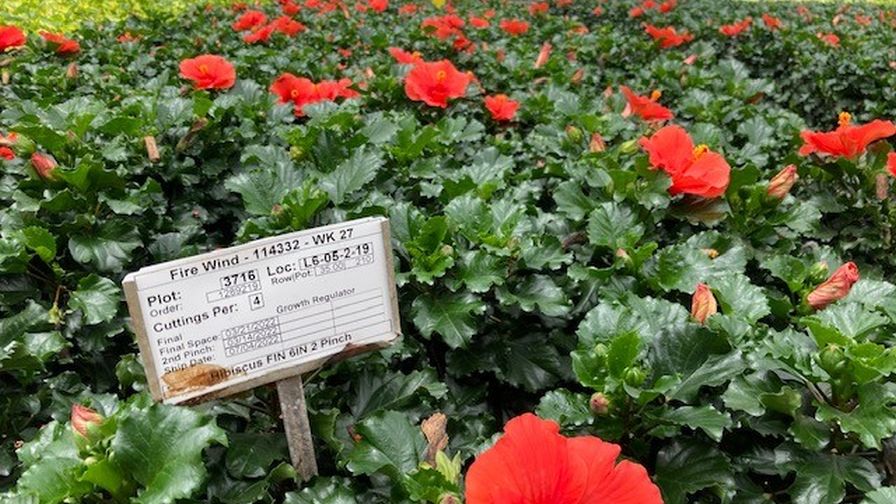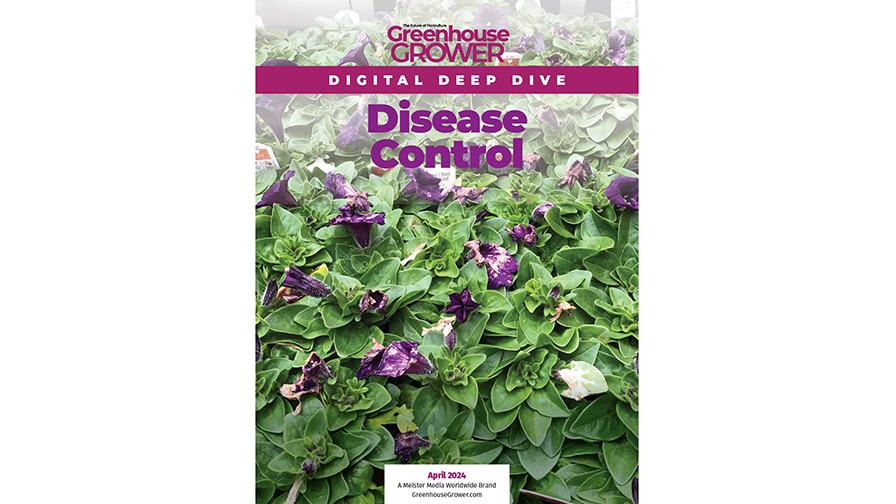Two Top 100 Growers on How Data Aids in Production and Sales

Crop cards, as seen here with hibiscus, show important data for the growing team. Photo: Aris Horticulture
In the age of information and technology, more growers are turning to data. Data collection and analysis can look like a daunting task, but when it is done correctly, it alleviates the workload. A greenhouse operation could track many different types of data, ranging from transplant dates to weather conditions to payroll.
The key, however, is how you use the data that you collect. Without analysis, data alone may not benefit your business. The team at a greenhouse must review and analyze the data, then use it to inform their decisions in the future. Data can help growers see inefficiencies in their production process or help a sales team track the remaining inventory.
Crop Data Streamlines Production Practices
Scott Stiles, General Manager of Henry Mast Greenhouses in Byron Center, MI, says the operation started looking into data collection about 15 years ago to improve organization and consistency when creating crop schedules. The team researched software systems to collect horticultural data and landed on Picas.
“The No. 1 reason we started down this road was crop management, so we could maintain crop schedules, produce products when we need them, and bring them to market,” Stiles says. “It also allows for functions that go with the crop we’re producing, such as spacing, chemical sprays, transplant dates, and harvest dates.”
Picas software prints out a crop sign with a QR code, and growers scan the code with a mobile device, such as a cell phone or tablet. The QR code shows information such as the name of the crop and its anticipated shipping date.
“Our growing staff is responsible for driving that crop to the production window,” Stiles says. “Everything is very transparent and organized.”
Dave Ogle, Director of Sales for Aris Horticulture in Barberton, OH, says his company also uses crop cards, which show the plant origin, upcoming spray dates, and more. These crop cards help the growing team work backwards. For example, if a crop should be finished in Week 10, it would be planted around Week 50.
To input data into Picas, Stiles says it all starts with the crop plan. Henry Mast’s production planning team sets up a crop plan for the season and posts it on Picas. The software then reads the data and issues helpful information, such as a transplant date based on the shipping week that was entered in the crop plan.
However, software cannot do it all. Stiles says workers are still needed to confirm that the software is using the most up-to-date numbers. For example, some plants may have been grown but are deemed unmarketable, due to a disease, insect, or failure to meet retail specifications. When plants are dumped, a human must enter the dump into Picas to calculate an updated inventory.
Humans are also needed to reconcile numbers, Stiles says. As crops are being transplanted, a laser eye reader counts the transplants and enters the data into Picas. If 1,000 plants were supposed to be transplanted, a worker will still count to ensure that the figure is correct. Sometimes, for instance, a worker’s hand may get in the way of the laser eye reader, so the count is not quite accurate.
“There’s a transplant verification that needs to happen just to confirm and reconcile that, like a bank statement. You want to make sure that what went through the belt is actually out in the greenhouse,” Stiles says. “From there, we can monitor the plan versus actual of what did we plant, is that what we were supposed to plant, and are we on target?”
When comparing anticipated numbers to actual numbers, Ogle says it depends on the crop. Aris employs graphical tracking to measure the height, width, and other specs of the crop to determine if it is on time. There is always a loss rate factored in, but some crops may be more prone to loss than others.
Stiles says data plays a major role in crop management at Henry Mast Greenhouses. Western Michigan is not always the sunniest place, and sometimes an extended stretch of cloudy days puts the production team behind schedule. The growing team evaluates the crop data and expected finishing dates based on the weather. Sometimes the team needs to add more weeks to the crop schedule.
“It comes down to timing,” Stiles says. “Almost all aspects of our business are based on a timeline we need to fulfill. There’s a constant adjustment happening there.”
Over the years, technology has been an important factor in operations at Henry Mast. Stiles says labor, shipping, and plant spacing have all been improved by data collection and analysis. The operation saves on labor by utilizing conveyor belts to move products in and out of the greenhouses and on to carts and trucks.
“The world of technology helped us with reliability and organization of our business,” Stiles says.
Sales Data Aids in Revenue
Ogle says sales data is instrumental in retaining current retail customers or reeling in past customers who haven’t bought products in awhile. Three to five years of sales data is helpful to the sales team when booking orders for the upcoming season. Ogle calls this data the “tickler file,” meaning that salespeople can review this information to see who bought what last year.
“Coming out of COVID, you didn’t have to work very hard to get orders,” Ogle says. “Now that the COVID purchasing habits are down, we have to go back to turning over rocks and canvassing our customer base that we may not have called lately. We have to go back and work a little harder.”
Historical sales data can also help the operations team plan for trucking, distribution, and forecasting needs. Aris creates a forecast three years out, using economic data, sales data, and consumer demand data for particular product lines.
“In this industry, we joke that we don’t have to go to Vegas, we gamble every day,” Ogle says.
Aris Horticulture uses SAP, a software service for crop management that offers real-time data insights. SAP has a strong accounting backbone, Ogle says, but it also manages production, forecasting, and inventory.
“Data allows us to be more educated on what we’re growing,” Ogle says. “There are some crops that a grower or manager likes, and we’ve always grown them. But if we’re seeing a trend that the consumers are not purchasing that crop, you need to make the decision to stop producing it. It goes back to historical sales data. If we’re tracking items that are not as prominent in the market, then we need to get out of that product and fill that space with a product that the consumer is interested in.”









